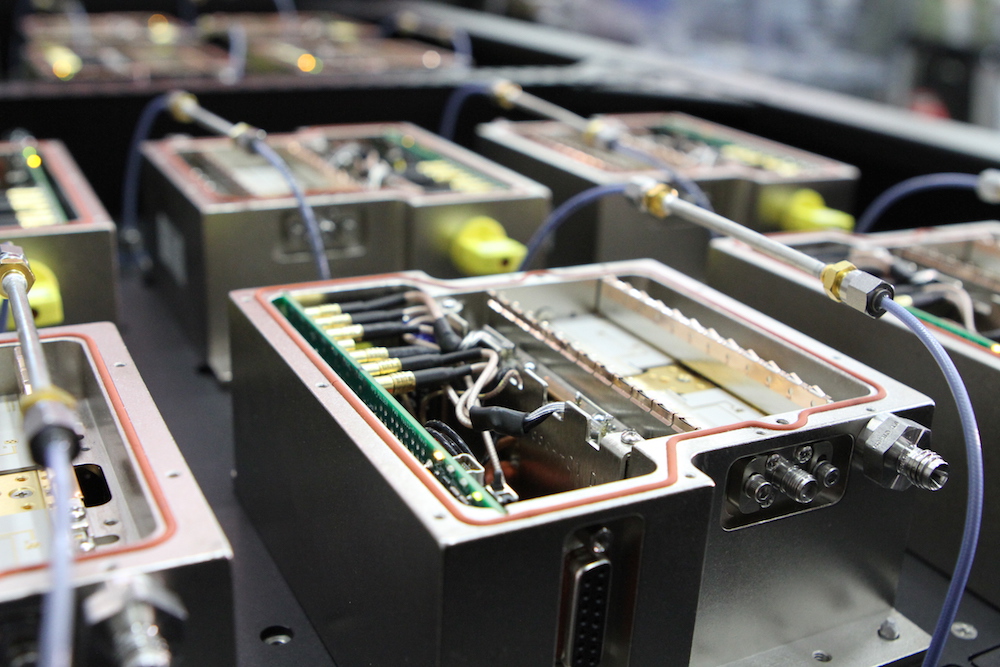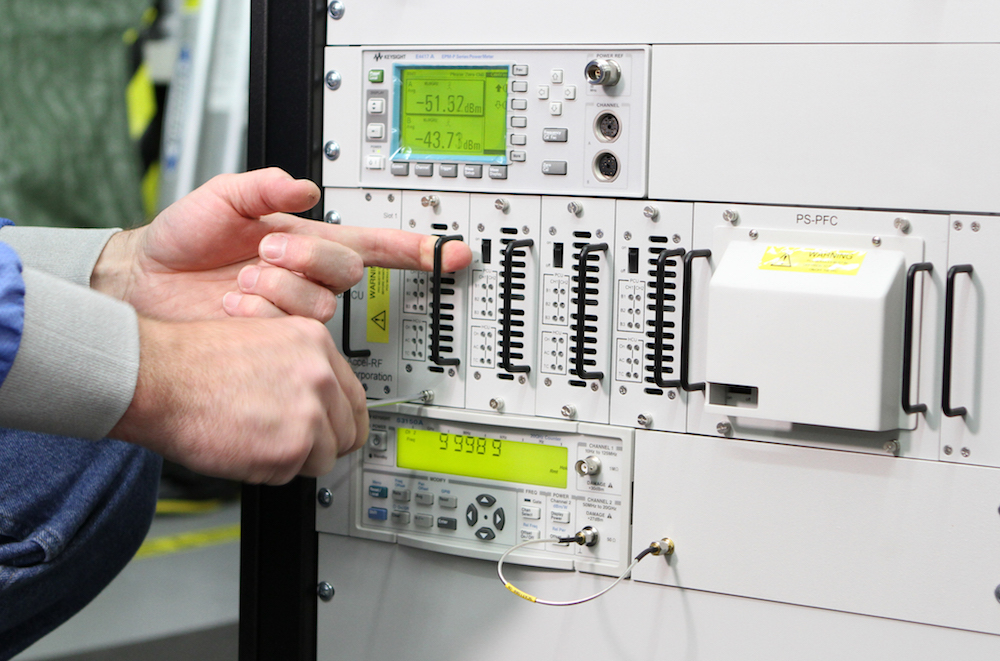![]()
MEETING THE NEW REALITIES OF TELECOMMUNICATIONS
In the last few decades, telecommunications has progressed from providing voice connections through landlines to connecting the world through mobile devices by text, video, and web services. Telecommunication has become an indispensable infrastructure for entertainment, news, social connectivity, and eCommerce. While the phones, tablets, and computers are the visible endpoints of the telecommunications network, its invisible backbone is the network of base stations that route the signals between each other and to end devices. Reliable base stations are essential for a robust telecom network.

IMPORTANT RELIABILITY PARAMETERS OF CONCERN
DC Bias Current
Active semiconductor components require a DC power supply to operate. The DC bias voltage and current levels are critical parameters as the power dissipation of each active element will contribute to temperature rise and drive overall efficiency.
Industries:
![]()
![]()
![]()
![]()
![]()
![]()
![]()
![]()
RF Output Power
The RF output power of an amplifier drives the overall capabilities of a transmitter. The saturation level and how the output power of a device compresses with input power is used to determine which applications and systems are suitable for that device.
Industries:
![]()
![]()
![]()
![]()
![]()
![]()
![]()
RF Gain
The ratio of RF power delivered to a load relative to the input power. How gain changes and compresses as these levels rise and approach saturation is critical to designing systems for any RF application.
Industries:
![]()
![]()
![]()
![]()
![]()
Ohmic Contact Resistance
In semiconductors, this is the intrinsic resistance through the metalized terminals of the device into the channel or junction. A physical change in the ohmic contacts, which can be an effect of metal migration, can change the resistance and impact the electrical performance of a device.
Industries:
![]()
![]()
Intermodulation Distortion
IMD occurs when two signals are present in a nonlinear system, such as an amplifier. The frequency harmonics of these two signals mix and create 2nd and 3rd order intermodulation products. Measuring and mitigating these distortion levels are critical for communication applications.
Industries:
![]()
![]()
![]()
![]()
Phase Noise
Commonly referred to as “jitter”, phase noise is the random fluctuations of the phase of a signal source. It is present in oscillators and digital clocks and can have detrimental effects on a system where frequency conversion takes place. A signal with high phase noise can end up occupying more of the spectrum than intended and introduce error.
Industries:
![]()
![]()
![]()
![]()
Noise Figure
This is a critical parameter in all Receiver designs. The Noise Figure must be low for a system to be sensitive enough to detect and process weak signals. Low Noise Amplifiers (LNA) are typically the first element in a receiver and are designed to minimize Noise Figure.
Industries:
![]()
![]()
![]()
![]()
![]()
Signal Linearity
For amplifiers in RF applications, this represents the relationship between the input power and the output power of a device. At low input power levels, linearity is uniformly quantified by the gain. As input drive increases, the device gain compresses as the device saturates and the linearity characteristics change.
Industries:
![]()
![]()
![]()
![]()
![]()
Switching Response Time
The rise and fall time of RF switches used in high-frequency applications can set limitations on the bandwidth and other key aspects of a system. When used in a phased array, the switching speed can limit how quickly the beam can be steered, for example.
Industries:
![]()
![]()
![]()
![]()
Frequency Stability
This represents the ability of a source, such as an oscillator, to maintain a constant frequency output. Outside influences such as temperature and change in bias voltage can lead to drift and affect frequency stability. Stability in communication systems is required so that a signal does not drift outside of its designated band.
Industries:
![]()
![]()
![]()
![]()
![]()
![]()
COMMON CHALLENGES OF THE TELECOMMUNICATIONS INDUSTRY
The telecommunications industry has to cope with the fast pace of technology, the global scope of its networks, ever-increasing traffic, and customer expectations of round the clock, faultless service at a reasonable price. All these factors result in many technical and operational challenges for the telecom industry. Some of the most significant challenges are:
- Functional readiness at constantly increasing frequencies.
- Reliability and lifetime testing under field conditions.
- Maximizing performance while minimizing costs.
Functional readiness at constantly increasing frequencies
Telecom devices have an insatiable appetite for data as newer applications like streaming video, games, and augmented and virtual reality features constantly demand ever-greater bandwidths. And, there is the imminent migration to 5G as well. Higher devices are more compact but often require larger arrays of elements, which adds complexity when evaluating the expected system-level lifetime of a transmitter.
Reliability and lifetime testing under field conditions
It is important for base station amplifier manufacturers to test their devices under conditions as close as possible to what they will experience in the field. The challenge is to conduct application-specific testing in a lab at high power levels with sufficient temperature control to dissipate high power while accurately recreating the worst-case ambient conditions expected in use. To collect device data and characterize performance under specific modulation types and different bias conditions require specialized equipment and expertise that device manufacturers may not have in-house.
Accel-RF test systems are unique in that they have the modularity and flexibility to allow Telecom-supporting foundries to perform the exact application-specific tests to recreate the conditions the devices will see in the field, both electrically and thermally, and track how key performance metrics change with age.
In base station applications, an amplifier in the transmitter chain will be running with some form of modulated RF signal, such as WCMDA or OFDMA, for data transmission. Accel-RF systems allow a statistically significant number of devices to be tested at once using the exact modulation scheme in order to perform various reliability studies. These can range from a 3-Temperature Accelerated Life Test in order to determine MTTF and expected lifetime of an element in an array, to an RF burn-in test under modulation to screen out early field failures.
During these tests, built-in data acquisition software measures first-order performance parameters, such as RF output power and gain and DC voltages and currents. The software also has the built-in capabilities to track Telecom-specific figures of merit, such as change in peak-to-average ratio (PAR) through the device with age. Special characterization tests can be configured to quantify any change in linearity characteristics with age, such as IMD3 levels. These are critical performance parameters for a device utilized in a base station transmitter, and manufacturers and system integrators would want to know of any potential shifts that would arise once the array is in use.
The high power density of GaN devices makes maintaining precise temperature control a difficult challenge when running any type of aging study, but Accel-RF systems are designed to test a population of high power devices at once over a wide range of temperatures. The test systems utilize liquid or air cooling to dissipate high power and have integrated heater elements to accelerate failure times or recreate worst-case field conditions.
The ability to characterize performance changes with age and predict lifetimes using identical conditions found in Telecom applications in a turnkey test system make Accel-RF an invaluable industry partner.

Maximizing performance while minimizing costs
Telecom networks have to be scalable enough to accommodate future growth, at least for the medium term. Growth implies more end devices running more applications that require greater bandwidth, predictable response times, and low latency.
The properties of Gallium Nitride (GaN) can help improve performance while reducing costs. The power density of GaN is a major competitive advantage, as it reduces the number of array elements needed in a transmitter when compared with silicon- or gallium-arsenide-based architectures. Since GaN can provide higher power in a smaller package, manufacturers can replace a whole array of legacy silicon and GaAs devices with a single GaN amplifier. The smaller array size will occupy a smaller footprint on the tower.
The benefits of GaN go much further than space and cost savings in just the array, however. Gallium-Nitride (GaN) based components have the ability to operate with much higher efficiencies compared to legacy, lower-cost silicon devices. This makes the technology a compelling choice for either new designs or replacing old Si-based infrastructure. If the device is more efficient, as GaN is, it requires less cooling, so manufacturers don’t have to worry about as much air or liquid cooling on the tower. Often, just at the base of the tower, storage units house all of the supporting power supplies, digital communications equipment, and cooling mechanisms. GaN semiconductors are more efficient and, therefore, require less in the storage facility.
WHY IS RELIABILITY TESTING IMPORTANT FOR BASE STATION COMPONENTS?
Base stations are located miles apart and telecom signals travel long distances between base stations and to end devices. Base stations must provide sufficient amplification to deliver telecom signals to the end devices and other nodes in the network without degrading the signal-to-noise ratio. The high frequency, high power amplifiers working in base stations are crucial for connectivity across the US, and then to the rest of the world through satellites. Due to their high power density, GaN semiconductor devices are used to make base station amplifiers.
Companies like Wolfspeed, NXP, and Ampleon who make the base station amplifiers require them to have large Mean Time to Failure (MTTF) values, typically five to ten years. The large MTTF is necessary for the long uptime expected of telecom networks. These companies use long duration reliability testing for characterizing device wear out and calculating expectations of device performance degradation to its end of life.

WHY WORK WITH ACCEL-RF?
As telecommunication base station manufacturers struggle to keep up with new technology and while continuing to meet consumer expectations, Accel-RF can work with them to solve their reliability and performance evaluation challenges. Accel-RF is an unequivocal world leader for performance and reliability testing under the elevated operating temperatures that telecom devices encounter in the field. It specializes in testing GaN, Silicon Carbide (SiC), and other compound semiconductor devices.
Since 2008, Accel-RF has been supplying modular, expandable, turnkey test systems to the world’s foremost semiconductor manufacturers. Its test systems feature DC, RF, and thermal tests on a single platform. They are easily configured and controlled by an intuitive software interface. Accel-RF test systems have a small footprint and are cost-competitive. Accel-RF provides exceptional customer service and top-notch expertise in accelerated life testing with RF-bias, high voltages, and high temperatures.
Contact Accel-RF today to learn more about our applications in the telecommunications industry.
